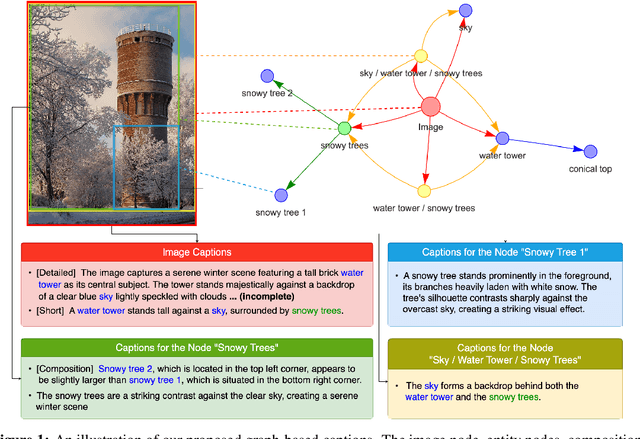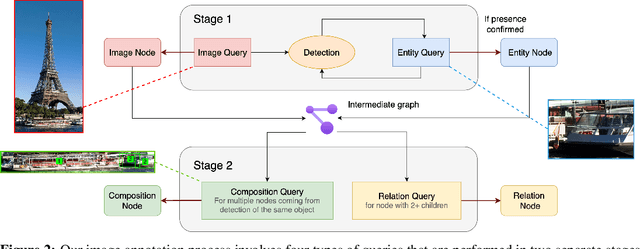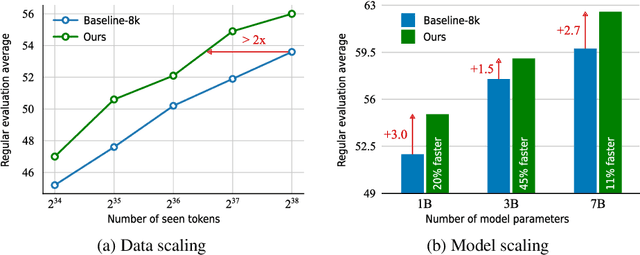Oncel Tuzel
FocalLens: Instruction Tuning Enables Zero-Shot Conditional Image Representations
Apr 11, 2025Abstract:Visual understanding is inherently contextual -- what we focus on in an image depends on the task at hand. For instance, given an image of a person holding a bouquet of flowers, we may focus on either the person such as their clothing, or the type of flowers, depending on the context of interest. Yet, most existing image encoding paradigms represent an image as a fixed, generic feature vector, overlooking the potential needs of prioritizing varying visual information for different downstream use cases. In this work, we introduce FocalLens, a conditional visual encoding method that produces different representations for the same image based on the context of interest, expressed flexibly through natural language. We leverage vision instruction tuning data and contrastively finetune a pretrained vision encoder to take natural language instructions as additional inputs for producing conditional image representations. Extensive experiments validate that conditional image representation from FocalLens better pronounce the visual features of interest compared to generic features produced by standard vision encoders like CLIP. In addition, we show FocalLens further leads to performance improvements on a range of downstream tasks including image-image retrieval, image classification, and image-text retrieval, with an average gain of 5 and 10 points on the challenging SugarCrepe and MMVP-VLM benchmarks, respectively.
TiC-LM: A Web-Scale Benchmark for Time-Continual LLM Pretraining
Apr 02, 2025Abstract:Large Language Models (LLMs) trained on historical web data inevitably become outdated. We investigate evaluation strategies and update methods for LLMs as new data becomes available. We introduce a web-scale dataset for time-continual pretraining of LLMs derived from 114 dumps of Common Crawl (CC) - orders of magnitude larger than previous continual language modeling benchmarks. We also design time-stratified evaluations across both general CC data and specific domains (Wikipedia, StackExchange, and code documentation) to assess how well various continual learning methods adapt to new data while retaining past knowledge. Our findings demonstrate that, on general CC data, autoregressive meta-schedules combined with a fixed-ratio replay of older data can achieve comparable held-out loss to re-training from scratch, while requiring significantly less computation (2.6x). However, the optimal balance between incorporating new data and replaying old data differs as replay is crucial to avoid forgetting on generic web data but less so on specific domains.
Mutual Reinforcement of LLM Dialogue Synthesis and Summarization Capabilities for Few-Shot Dialogue Summarization
Feb 24, 2025Abstract:In this work, we propose Mutual Reinforcing Data Synthesis (MRDS) within LLMs to improve few-shot dialogue summarization task. Unlike prior methods that require external knowledge, we mutually reinforce the LLM\'s dialogue synthesis and summarization capabilities, allowing them to complement each other during training and enhance overall performances. The dialogue synthesis capability is enhanced by directed preference optimization with preference scoring from summarization capability. The summarization capability is enhanced by the additional high quality dialogue-summary paired data produced by the dialogue synthesis capability. By leveraging the proposed MRDS mechanism, we elicit the internal knowledge of LLM in the format of synthetic data, and use it to augment the few-shot real training dataset. Empirical results demonstrate that our method improves dialogue summarization, achieving a 1.5% increase in ROUGE scores and a 0.3% improvement in BERT scores in few-shot settings. Furthermore, our method attains the highest average scores in human evaluations, surpassing both the pre-trained models and the baselines fine-tuned solely for summarization tasks.
3D Shape Tokenization
Dec 24, 2024



Abstract:We introduce Shape Tokens, a 3D representation that is continuous, compact, and easy to incorporate into machine learning models. Shape Tokens act as conditioning vectors that represent shape information in a 3D flow-matching model. The flow-matching model is trained to approximate probability density functions corresponding to delta functions concentrated on the surfaces of shapes in 3D. By attaching Shape Tokens to various machine learning models, we can generate new shapes, convert images to 3D, align 3D shapes with text and images, and render shapes directly at variable, user specified, resolution. Moreover, Shape Tokens enable a systematic analysis of geometric properties such as normal, density, and deformation field. Across all tasks and experiments, utilizing Shape Tokens demonstrate strong performance compared to existing baselines.
FastVLM: Efficient Vision Encoding for Vision Language Models
Dec 17, 2024



Abstract:Scaling the input image resolution is essential for enhancing the performance of Vision Language Models (VLMs), particularly in text-rich image understanding tasks. However, popular visual encoders such as ViTs become inefficient at high resolutions due to the large number of tokens and high encoding latency caused by stacked self-attention layers. At different operational resolutions, the vision encoder of a VLM can be optimized along two axes: reducing encoding latency and minimizing the number of visual tokens passed to the LLM, thereby lowering overall latency. Based on a comprehensive efficiency analysis of the interplay between image resolution, vision latency, token count, and LLM size, we introduce FastVLM, a model that achieves an optimized trade-off between latency, model size and accuracy. FastVLM incorporates FastViTHD, a novel hybrid vision encoder designed to output fewer tokens and significantly reduce encoding time for high-resolution images. Unlike previous methods, FastVLM achieves the optimal balance between visual token count and image resolution solely by scaling the input image, eliminating the need for additional token pruning and simplifying the model design. In the LLaVA-1.5 setup, FastVLM achieves 3.2$\times$ improvement in time-to-first-token (TTFT) while maintaining similar performance on VLM benchmarks compared to prior works. Compared to LLaVa-OneVision at the highest resolution (1152$\times$1152), FastVLM achieves comparable performance on key benchmarks like SeedBench and MMMU, using the same 0.5B LLM, but with 85$\times$ faster TTFT and a vision encoder that is 3.4$\times$ smaller.
Synth4Seg -- Learning Defect Data Synthesis for Defect Segmentation using Bi-level Optimization
Oct 24, 2024Abstract:Defect segmentation is crucial for quality control in advanced manufacturing, yet data scarcity poses challenges for state-of-the-art supervised deep learning. Synthetic defect data generation is a popular approach for mitigating data challenges. However, many current methods simply generate defects following a fixed set of rules, which may not directly relate to downstream task performance. This can lead to suboptimal performance and may even hinder the downstream task. To solve this problem, we leverage a novel bi-level optimization-based synthetic defect data generation framework. We use an online synthetic defect generation module grounded in the commonly-used Cut\&Paste framework, and adopt an efficient gradient-based optimization algorithm to solve the bi-level optimization problem. We achieve simultaneous training of the defect segmentation network, and learn various parameters of the data synthesis module by maximizing the validation performance of the trained defect segmentation network. Our experimental results on benchmark datasets under limited data settings show that the proposed bi-level optimization method can be used for learning the most effective locations for pasting synthetic defects thereby improving the segmentation performance by up to 18.3\% when compared to pasting defects at random locations. We also demonstrate up to 2.6\% performance gain by learning the importance weights for different augmentation-specific defect data sources when compared to giving equal importance to all the data sources.
GSM-Symbolic: Understanding the Limitations of Mathematical Reasoning in Large Language Models
Oct 07, 2024



Abstract:Recent advancements in Large Language Models (LLMs) have sparked interest in their formal reasoning capabilities, particularly in mathematics. The GSM8K benchmark is widely used to assess the mathematical reasoning of models on grade-school-level questions. While the performance of LLMs on GSM8K has significantly improved in recent years, it remains unclear whether their mathematical reasoning capabilities have genuinely advanced, raising questions about the reliability of the reported metrics. To address these concerns, we conduct a large-scale study on several SOTA open and closed models. To overcome the limitations of existing evaluations, we introduce GSM-Symbolic, an improved benchmark created from symbolic templates that allow for the generation of a diverse set of questions. GSM-Symbolic enables more controllable evaluations, providing key insights and more reliable metrics for measuring the reasoning capabilities of models.Our findings reveal that LLMs exhibit noticeable variance when responding to different instantiations of the same question. Specifically, the performance of all models declines when only the numerical values in the question are altered in the GSM-Symbolic benchmark. Furthermore, we investigate the fragility of mathematical reasoning in these models and show that their performance significantly deteriorates as the number of clauses in a question increases. We hypothesize that this decline is because current LLMs cannot perform genuine logical reasoning; they replicate reasoning steps from their training data. Adding a single clause that seems relevant to the question causes significant performance drops (up to 65%) across all state-of-the-art models, even though the clause doesn't contribute to the reasoning chain needed for the final answer. Overall, our work offers a more nuanced understanding of LLMs' capabilities and limitations in mathematical reasoning.
MUSCLE: A Model Update Strategy for Compatible LLM Evolution
Jul 12, 2024



Abstract:Large Language Models (LLMs) are frequently updated due to data or architecture changes to improve their performance. When updating models, developers often focus on increasing overall performance metrics with less emphasis on being compatible with previous model versions. However, users often build a mental model of the functionality and capabilities of a particular machine learning model they are interacting with. They have to adapt their mental model with every update -- a draining task that can lead to user dissatisfaction. In practice, fine-tuned downstream task adapters rely on pretrained LLM base models. When these base models are updated, these user-facing downstream task models experience instance regression or negative flips -- previously correct instances are now predicted incorrectly. This happens even when the downstream task training procedures remain identical. Our work aims to provide seamless model updates to a user in two ways. First, we provide evaluation metrics for a notion of compatibility to prior model versions, specifically for generative tasks but also applicable for discriminative tasks. We observe regression and inconsistencies between different model versions on a diverse set of tasks and model updates. Second, we propose a training strategy to minimize the number of inconsistencies in model updates, involving training of a compatibility model that can enhance task fine-tuned language models. We reduce negative flips -- instances where a prior model version was correct, but a new model incorrect -- by up to 40% from Llama 1 to Llama 2.
Graph-Based Captioning: Enhancing Visual Descriptions by Interconnecting Region Captions
Jul 09, 2024



Abstract:Humans describe complex scenes with compositionality, using simple text descriptions enriched with links and relationships. While vision-language research has aimed to develop models with compositional understanding capabilities, this is not reflected yet in existing datasets which, for the most part, still use plain text to describe images. In this work, we propose a new annotation strategy, graph-based captioning (GBC) that describes an image using a labelled graph structure, with nodes of various types. The nodes in GBC are created using, in a first stage, object detection and dense captioning tools nested recursively to uncover and describe entity nodes, further linked together in a second stage by highlighting, using new types of nodes, compositions and relations among entities. Since all GBC nodes hold plain text descriptions, GBC retains the flexibility found in natural language, but can also encode hierarchical information in its edges. We demonstrate that GBC can be produced automatically, using off-the-shelf multimodal LLMs and open-vocabulary detection models, by building a new dataset, GBC10M, gathering GBC annotations for about 10M images of the CC12M dataset. We use GBC10M to showcase the wealth of node captions uncovered by GBC, as measured with CLIP training. We show that using GBC nodes' annotations -- notably those stored in composition and relation nodes -- results in significant performance boost on downstream models when compared to other dataset formats. To further explore the opportunities provided by GBC, we also propose a new attention mechanism that can leverage the entire GBC graph, with encouraging experimental results that show the extra benefits of incorporating the graph structure. Our datasets are released at \url{https://huggingface.co/graph-based-captions}.
Dataset Decomposition: Faster LLM Training with Variable Sequence Length Curriculum
May 21, 2024



Abstract:Large language models (LLMs) are commonly trained on datasets consisting of fixed-length token sequences. These datasets are created by randomly concatenating documents of various lengths and then chunking them into sequences of a predetermined target length. However, this method of concatenation can lead to cross-document attention within a sequence, which is neither a desirable learning signal nor computationally efficient. Additionally, training on long sequences becomes computationally prohibitive due to the quadratic cost of attention. In this study, we introduce dataset decomposition, a novel variable sequence length training technique, to tackle these challenges. We decompose a dataset into a union of buckets, each containing sequences of the same size extracted from a unique document. During training, we use variable sequence length and batch size, sampling simultaneously from all buckets with a curriculum. In contrast to the concat-and-chunk baseline, which incurs a fixed attention cost at every step of training, our proposed method incurs a penalty proportional to the actual document lengths at each step, resulting in significant savings in training time. We train an 8k context-length 1B model at the same cost as a 2k context-length model trained with the baseline approach. Experiments on a web-scale corpus demonstrate that our approach significantly enhances performance on standard language evaluations and long-context benchmarks, reaching target accuracy 3x faster compared to the baseline. Our method not only enables efficient pretraining on long sequences but also scales effectively with dataset size. Lastly, we shed light on a critical yet less studied aspect of training large language models: the distribution and curriculum of sequence lengths, which results in a non-negligible difference in performance.
 Add to Chrome
Add to Chrome Add to Firefox
Add to Firefox Add to Edge
Add to Edge